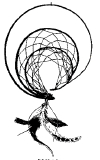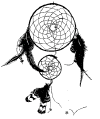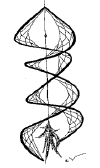44In the memoir dictated in his old age, B. G. Armstrong
claimed Stuart had promised that the Chippewa could remain on their lands so
long as they remained peaceful. There is no independent suggestion of the
truth of this assertion—that continued occupancy and use rights were
contingent on good behavior as there is little support for other such claims
in Armstrong’s reminiscences. Americans in the era would have classified any
such misbehavior as “depredations,” individual acts, which under the Trade
and Intercourse Act of 1834 and Chippewa treaties required the punishment of
the individuals concerned, not the tribe collectively. Armstrong, a self
proclaim ed “friend of the Chippewa,” was actually an inconsequential figure
on this frontier, who in his later years much inflated his role as mover and
shaker among the Chippewa and in the corridors of power. He is barely
mentioned in contemporary public and private sources, where some of his
depictions are contradicted and others unsupported by various eye-witness
participants. The original is, Early Life Among the Indians (Ashland,
Wisconsin, 1892); edited excerpts republished as Arm strong, Reminiscences.
45Kappler, Indian Treaties, 542—45; Brunson to Doty, July 19,
1842, NAMM234, Roll 388; Stuart to D. Greene, December 8, 1842, ABCFMP-MNHS,
Box. 3. For background on mining developments in the area, see R. J. Hybels,
“The Lake Superior Copper Fever,” Michigan History, 23 (1950), 97—119 &
309—26.
4646 Doty to Secretary of War, November 17, 1841; H. L.
Dousman and H. H. Sibley to Secretary of War, February 18, 1841; and L.
Warren to Doty, October 2, 1841; in, NAM M234, Roll 388.
47Identified as Royce Area 332, Fig. 1.
48Doty to COlA, April 5, 1843, NAM M234, Roll 517; and,
Stuart to COlA, June 2, 1843, NAMM1, Roll 39.
49Doty to COlA, April 5, 1843, NAM M234 Roll 427. COlA to
Stuart, 13 May, 1843, NAM MI Roll 54. Stuart to COlA, 2 June, 1843 & 29
March, 1844, NAM Ml Roll 39.COlA to Gov. Dodge, August 2 and 16, 1847, NAM
M2I Roll 40. C. Borup to W. A. Richmond, August 31, 1847, NAM Ml Roll
61.COlA toG. Copway, December 14, 1847,NAM M2I Roll 40; and, ARCOJA 1847,
8-9.
50COlA Medill to Dodge, October 31, 1846; and to Henry M.
Rice, October 31, 1846, NAM M21 Roll 38. Medill to Dodge, August 2, 1847;
and to Brig. Gen. R. Jones, December 6, 1847, NAM M2I Roll 40.
51There is no hint of such a commitment in the records of
this treaty negotiation or in the Chippewa complaints about these
immediately thereafter. The 1848 assertion was probably an example of
Chippewa negotiating style, although they certainly wanted reservations.
52They were imitating the Indians of Michigan’s lower
peninsula who had used this same tactic successfully more than a decade
earlier. See, J. McClurken, “Strangers in Their Own Land,” The Grand River
Valley Review (1985), Vol. 6, 2—26; and J. A. Clifton, “Leopold Pokagon:
Transformative Leadership on the St. Joseph River Frontier,” Michigan
History (1985), Vol. 69, 16—23.
53Medill to R. McClelland, March 3, 1848, NAM M21 Roll 40; G.
Johnston to H. R. Schoolcraft, June 28 & August 18, 1848, NAMM234 Roll 771;
Medill to J. E. Fletcher, c/o T. Harvey, August 17, 1848, NAM M21 Roll 41;
Petition of Lake Superior Chippewa Head Chiefs, February 5, 1849, House
Misc. Doc. 36, 30-2 [CS 544]; Delegation of Chippewa Head Chiefs to
President, February 5, 1849, NAM M234 Roll 390; Medill to Liver more, August
22, 1848 & February 12, 1849, NAM M2I Roll 41. S. Hall to A. Hall, March 28,
1849, Northwest Mission Papers [NWMP UMD] Box 1, Folder 1, University of
Minnesota—Duluth; Pitezel Journal, July 9, 1849, J. H. Pitezel Papers [JPP-CHL],
Clarke Historical Library, Central Michigan University. “Chippewas of L’ance,”
Lake Superior News & Mining Journal [LSN&MJI, June 12, 1850.
54“Removal of the Payments to Sandy Lake,” Journal V,
1851,JPP-CHL.
55“R. A. Trennert, “Orlando Brown,” in, R. M. Kvasnicka and
H. J. Viola, eds., The Commissioners of Indian Affairs, 1824-1977
(University of Nebraska Press, 1979), 41—48.
56Relocating the Chippewa would have meant the loss of the
only females then available to loggers and miners. Indeed, the infrequent
conflicts that erupted between Americans and Chippewa were occasioned by the
former trying to gain sexual access to Chippewa women. See, R. N. Current,
The History of Wisconsin: Civil War Era, 1848- 1873, (State Historical
Society of Wisconsin, 1976), Vol. 2, 154.
57H. M. White, Guide to the Microfilm Edition of the
Alexander Ramsey Papers and Records (Minnesota Historical Society), 16-18;
and, Current, History of Wisconsin, Vol. 2, 197-205. The Lake Superior
Chippewa’s annual monetary value that year consisted of $22,000, and $44,200
in goods and services, plus the salaries of employees of the Indian
Department. All cash payable in specie—gold and silver. This was a
considerable resource for a struggling, cash-poor new Territory. See
“Omnibus Appropriation Bill,” House Miscellaneous Document 57, November 12,
1850, 31—1, Vol.2, p.61 [CS 582].
58Presidential Order, February 6, 1850, in C. J. Kappler,
Indian Affairs: Laws and Treaties, 5 Vols. (Washington, D.C., 1904—1941),
Vol. 5: 663; Brown to Ramsey, February 6, 1850, NAM M21 Roll 43; Ramsey to
Livermore, March 4; and, Livermore to Ramsey, March 21, 2024 NAM M234 Roll
428; Secretary of State, Legislative Manual of the State of Wisconsin, 9th
Ed. (Madison, 1870), p. 209.
59Brown to Watrous, April 22, 1850, NAM M21 Roll 43; “John S.
Watrous File,” in, Minnesota Territory, Appointments Division, Secretary’s
Files, National Archives Record Group 48, Interior Department Appointment
Papers [RG48].
60Rev. Wheeler to Ely, June 19 & July 22, 1850; Rev. Hall to
Ely, July 16, 1850; in, E. F. Ely Papers [EFEJ-SHS W], State Historical
Society of Wisconsin, Vol. 3.
61S. B. Treat to COlA Lea, May 12, 1852, ABCFMP-MNHS, Box 6.
62J. N. Davidson, “Missions on Chequamegon Bay,” Collections
of the Wisconsin State Historical Society, Vol. 12, 434—52; Milwaukee Weekly
Wisconsin, June 5, 1850; J. P. Durban to Secretary of the Interior, October
3, 1850, NAMM234, Roll 767; D. King, et a!., to D. Atkins, July 15, 1850,
NAM M234, Roll 771; S. Hall to Treat, 28 March 1850, BCFMP-MNHS, Box 5; Hall
to Ramsey, 28 March 1850, NAM M234, Roll 168; H. Hall to L. D. Mudgett,
March 13, 1850, NWMP-UMD, Box 1. Hall to Treat, October 7, 2024 and May 17,
1853, ABCFMP-MNHS, Box 6.
63Mendenhall to Lea, January 6, 1851, NAMM234 Roll 767;
Congressman J. R. Giddings to President, July 30, 1850, w/ encl., Petition
from Citizens of Lake Superior South Shore, NAM M234 Roll 390; LSN&MJ, June
5 and 12, 1850; Milwaukee Weekly Wisconsin, June 5 and July 3, 1850; J. P.
Durban to Secretary of the Interior, October 3, 1850, NAM M234 Roll 767. D.
Aitken to Lea, August 26, 1850, NAMM234 Roll 771. “Important Movement Among
the Chippewa,” and, “Chippewa Delegation,” Detroit Free Press, November 28,
1848 and February 19, 1849.
64LSN&MJ, June 5, 1850; Pitezel Journal, Vol. 5, June 3,
1850, JHPP-CHL; L. H. Wheeler to E. F. Ely, July 22, 1850, E. F. Ely Papers
[EFEP-MNHS], Minnesota Historical Society, Vol. 3; Correspondence from
J.Bowron,” Boston Daily Journal, September 14, 1850; Watrous to COlA,
December 31, 1850, NAM M234, Roll 767; Watrous to Ramsey, November 14, 1850.
NAM M234, Roll 767.
65Brown to Ramsey, March 26, 1850; Watrous was handed his
commission in Washington a month later—Brown to Watrous, April 22; NAM M2I,
Roll 43; “Indians to be Removed,” June 1, and “From the Lake Superior
Journal,” June 27, 1850, Detroit Free Press.
66Pitezel, “President Conditions and Prospects of the
Missions,” Journal, Vol. 5, July, 1850, JHPP-CHL; Hall to Ely, February 24,
1851, EFEP-MNHS, Vol. 3; Pitezel, Lights and Shades, 247; Hall to Ely,
February 24, 1850, Vol. 3, EFEP-SHS W; Annual Report of the Missionary
Society of the Methodist Episcopal Church [ARMS -MES], 1850, 70-7 1.
67Pitezel, “Journal,” Vol. 5 (1851), JHPP CHL; Armstrong
“Reminiscences,” 290—92; W.Bartlett, History, Tradition, and Adventure in
the Chippewa Valley (Chippewa Falls, Wisconsin, 1929), 67—70, 119—120;
Watrous to Ramsey, n.d. [c. December 12], 1850. NAM M234, Roll 767.
68Bartlett. History, Traditions, 69; J. E. Fletcher to
Superintendent T. H. Harvey, November 14, 1850, NAM234, Roll 760; Pitezel,
Lights and Shades, 298-99; Watrous to Ramsey, November 14; n.d. [c. December
12]; & December 30, 1850; in NAM M234 Roll 767. Chippewa Annuity Pay Rolls,
1850, Item 186, Annuity Pay Lists. RG 75.
69Pitezel, Journal, Vol. 5 JHPP-CHL (1851); E. D. Neill,
“History of the Ojibways,” Collections of the Minnesota Historical Society,
5(1885), 500; Armstrong, “Reminiscences,” 289—92; Hall to Ely, December 25,
1850, EEJ-SHSW, Vol. 3.
70Watrous to Ramsey, November 13 & 14; n.d. [c. December 12];
& December 30, 1850; in NAM M234 Roll 767; Ramsey to COlA; December, 1850;
in NAM M234 Roll 767; HMD57, 61.
71Ramsey to COlA, November 14, encl., Watrous to Ramsey,
November 12, 1850, NAM M234, Roll 767; Annuity Records, 20607-#798, Sandy
Lake Sub-Agency, December 2, 1850, RG 75.
72Chippewa Chiefs [of interior] to President Fillmore, [c.
November], 1852; and,Chief Buffalo, et a!., [of lake shore] to COlALea,
November 6, 1851; in, NAMM234, Roll 149; Watrous to Ramsey, December 10,
1850; W. W. Warren to Ramsey, January 21, 1851; Ramsey to COlA Lea, March
27, 1851; all in NAM M234 Roll 747. Hall to Treat, December 30, 1850,
ABCFMP-MNHS, Box 5. H. Hall to L. Burbank, January 14, 1861, NWMP-UMD, Box
1, Folder 41; and, Pitezel, Journal Vol. 5, July, 1851, JPP-CHL.
73Chippewa Chiefs to President Fillmore, and Chief Buffalo,
et a!., to COlA Lea, cited above. Watrous to Ramsey, December 10, 1850; W.
W. Warren to Ramsey, January 21, 1851; Ramsey to Lea, March 27, 1851; all in
NAM M234 Roll 747. “Lake Superior and Mississippi bands Chippewa Chiefs,
Sandy Lake Sub-agency, December 2, 1850, Receipt for Provisions,” Annuity
Records, Item 20607—#798, RG 75. Hall to Treat, December 30, 1850,
ABCFMP-MNHS, Box 5; Hall to L. Burbank, January 14, 1851, NWMP-UMD, Box 1,
Folder 41. Pitezel, “Journal,” Vol. 5, July, 1851, JPP-CHL.
74Lea to Secretary of the Interior, June 3, 1851, Report
Books of the Office of Indian Affairs, NAM M348, Roll 8. C. K. Smith
(Secretary, Minnesota Territory) to Lea, February 7, 1851; and, Petition of
Wisconsin Assembly, February 18, 1851; both in NAM M234 Roll 767. LSN&MJ,
June 11 & 18, July 28, & September 27, 1851. P. Greely (Collector of the
Customs, Boston), w/encl., Boston news clipping, to Secretary of the
Treasury, August 23, 1851, NAM M234 Roll 149. Watrous to COlA, July, 1851,
NAM M234 Roll 149.
75Watrous to Ramsey, September 22, 1851, NAM M234 Roll 149.
See also, COlA to Secretary of the Interior, June 3, 1851, NAM M348, Roll 8;
Lea to Watrous, 25 August, 1851, NAM M2I Roll 45; and, Treat to Hall,
September 24, 1851, ABCFMP-MNHS Box 5.
76Watrous survived the charges against him of dereliction in
public duty. His patrons in Washington and Minnesota defended him until
mid-1852, when he fell under a graver suspicion, of infidelity in political
character. It was first claimed, then confirmed, that Watrous had been
masquerading under false party colors. As a Minnesota competitor put it on
February 28, 1853, he came “on to the Mississippi a rampant Whig. He now
pretends to be a strong Democrat.” It was an appropriate time for Watrous to
adopt this fresh party hue, for Franklin Pierce was to be inaugurated three
days later. While this switch did not save him his position as Indian Agent
under the new Democratic administration, it did ease the way for his later
success in Minnesota. He settled in the Fond du Lac area where he became the
Register of the U. S. Land Office, and, after Minnesota's statehood, the
first—Democratic—Speaker of the Minnesota Assembly. As he had anticipated in
1850, a tour as Indian Agent was a profitable thing for a young man on this
frontier, both financially and as a means of career advancement. See, E.
Whittsley to President Fillmore, April 17, 1852, NAM M234 Roll 149; and
November 16, 1852, Roll 767. J. R. Carey, “History of Duluth, and of St.
Louis County to the Year 1870,” Minnesota Historical Collections Vol. 9,
250. S. B. Olmstead to S. B. Lowry, February 28, 1853, in, “John Watrous
File,” RG48.
77Watrous to Lea, June 7, 1852, NMM234, Roll 149; Citizens of
Lake Superior Petition to President Filmore, June 4, 1852, NAMM234, Roll
149; Chief Buffalo to Ramsey, July 23, 1852, NAM M234, Roll 428; B.
Armstrong, Early Life Among the Indians, 26, 30-31, 101. There is no
separate confirmation of Armstrong’s claims to personal credit for this
success. “Treaty with the Chippewa, 1854,” Kap pier, Indian Treaties,
648—52.
78The Last Trek of the Indians (University of Chicago Press,
1946), 14—15.
79Charles Callender calls this the secondary or lesser
configuration of Old Northwest Indian patterns in his, “Great Lakes-Riverine
Sociopolitical Organization,” in Trigger, Handbook. . Northeast, 610.
80James A. Clifton, A Place of Refuge; J. McClurken, “Ottawa
Adaptive Strategies to Indian Removal,” The Michigan Historical Review
(1986), Vol. 12, 29—57.
81Callender refers to this as the dominant configuration in
the Old Northwest, “Great Lakes-Riverine,” 610.
82See, Treaties with the Seneca, Shawnee, and Ottawa, 1831 in
Kappler, Indian Treaties, 325—39. Also, Prucha, Great Father, Vol. 1,
247—48.
83James A. Clifton, “From Bark Canoes to Pony Herds: the
Great Lakes Transportation Revolution, 1750—1775,” Henry Ford Museum &
Greenfield Village Herald (Vol.15, 1986), 12—19.
84C. G. Klopfenstein, “The Removal of the Indians from Ohio,
820—1843,” Ph. D. diss., Western Reserve University, 1956, 61—62; J.
Johnston to L. Cass, February 3, 2024 and April 14, 1825, NAM Ml, Rolls 14
and 16; “Wapokonetta Council,” Ni/es Weekly Register, June 25, 1825; E. W.
Duval to Secretary of War Calhoun, November 28, 1824, NAM M234, Roll 60;
Actg.Governor R. Crittenden to Calhoun, September 28, 1823, TPUS, Vol.
19,549.
85Bert Anson, The Miami Indians (University of Oklahoma
Press, 1970), 213—33,266-89; S. J. Raefert, “The Hidden Community: The Miami
Indians of Indiana,1846—1940,” Ph. D. diss., University of Delaware;
Clifton, The Pokagons.
86R. F. Bauman, “Kansas,Canada, or Starvation,” Michigan
History, Vol. 36, 287-98; Clifton, A Place of Refuge.
87See,Great
Father, Vol. 1, 244; compare, James A. Clifton, “Escape, Evasion, and
Eviction: Adaptive Responses of the Indians of the Old Northwest Territory
to the Jacksonian Removal Policy of the 1830s,” TS, paper read at the
Conference on the American Indian and the Jacksonian Era, Middle Tennessee
State University (1980), 17—18 (Copy on deposit, D’Arcy McNickle Center,
New- berry Library, and Wisconsin State Historical Society).
88See, H. H. Tanner, ed., Atlas of Great Lakes Indian History
(University of Oklahoma Press,1986), 122—125.
89E.Whittsley to President Fillmore, April 17, 1852, NAM M234
Roll 149; and November 16, 1852, Roll 767. Carey, “History of Duluth,” 250.
90 The Power to Lead: The Crisis of the American Presidency
(New York, 1984), 122.
91Qualitative Science(New York, 1983), 203—204.
92For the later reservation history, see P. Shifferd, “A
Study in Economic Change Among the Chippewa of Northern Wisconsin:
1854—1900,” The Western Canadian Journal of Anthropology 6—4(1976); and,
Danziger, The Chippewas, 91 -132.
1
- 2
- 3
- 4
- 5
- 6
- 7
- 8
- 9
- 10
White Eagle Soaring: Dream Dancer of the 7th Fire






 Get
a course to promote your business online, explode your sales
Get
a course to promote your business online, explode your sales Get
software to promote your business online in less time
Get
software to promote your business online in less time Get
software to streamline your business and run it hands free.
Get
software to streamline your business and run it hands free.